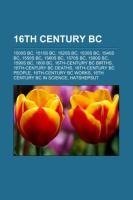
16th century BC
Source: Wikipedia. Pages: 24. Chapters: 1500s BC, 1510s BC, 1520s BC, 1530s BC, 1540s BC, 1550s BC, 1560s BC, 1570s BC, 1580s BC, 1590s BC, 1600 BC, 16th-century BC births, 16th-century BC deaths, 16th-century BC people, 16th-century BC works, 16th century... Viac o knihe
Produkt je dočasne nedostupný
13.29 €
bežná cena: 15.10 €
O knihe
Source: Wikipedia. Pages: 24. Chapters: 1500s BC, 1510s BC, 1520s BC, 1530s BC, 1540s BC, 1550s BC, 1560s BC, 1570s BC, 1580s BC, 1590s BC, 1600 BC, 16th-century BC births, 16th-century BC deaths, 16th-century BC people, 16th-century BC works, 16th century BC in science, Hatshepsut, 1509-1500 BC, List of 16th century BCE lunar eclipses, Thutmose I, Seqenenre Tao II, Battle of Mingtiao, Mask of Agamemnon, Senakhtenre Tao I, Tai Jia, Tempest Stele, Sobekemsaf II, Labarna I, Hantili I, Stela of Queen Tetisheri, Hattusili I, Ammi-Saduqa, Puzur-Ashur III, Zidanta I, Ahmose-ankh, List of sovereign states in the 16th century BC, Silver Siege Rhyton. Excerpt: Hatshepsut ( ; also Hatchepsut; meaning Foremost of Noble Ladies; 1508-1458 BC) was the fifth pharaoh of the eighteenth dynasty of Ancient Egypt. She is generally regarded by Egyptologists as one of the most successful pharaohs, reigning longer than any other woman of an indigenous Egyptian dynasty. Although contemporary records of her reign are documented in diverse ancient sources, Hatshepsut was described by early modern scholars as only having served as a co-regent from about 1479 to 1458 BC, during years seven to twenty-one of the reign previously identified as that of Thutmose III. Today it is generally recognized that Hatshepsut assumed the position of pharaoh and the length of her reign usually is given as twenty-two years, since she was assigned a reign of twenty-one years and nine months by the third-century BC historian, Manetho, who had access to many records that now are lost. Her death is known to have occurred in 1458 BC, which implies that she became pharaoh circa 1479 BC. Although it was uncommon for Egypt to be ruled by a woman, the situation was not unprecedented. As a regent Hatshepsut was preceded by Merneith of the first dynasty, who was buried with the full honors of a pharaoh and may have ruled in her own right. Nimaethap of the third dynasty may have been the dowager of Khasekhemwy, but certainly acted as regent for her son, Djoser, and may have reigned as pharaoh in her own right. Queen Sobekneferu of the Twelfth Dynasty is known to have assumed formal power as ruler of "Upper and Lower Egypt" three centuries earlier than Hatshepsut. Ahhotep I, lauded as a warrior queen, may have been a regent between the reigns of two of her sons, Kamose and Ahmose I, at the end of the seventeenth dynasty and the beginning of Hatshepsut's own eighteenth dynasty. Amenhotep I, also preceding Hatshepsut in the eighteenth dynasty, probably came to power while a young child and his mother, Ahmose-Nefertari, is thought to have been a regent for him. Other women
- Vydavateľstvo: Books LLC, Reference Series
- Formát: Paperback
- Jazyk:
- ISBN: 9781157729877


 Anglický jazyk
Anglický jazyk 




 Ruský jazyk
Ruský jazyk 



 Nemecký jazyk
Nemecký jazyk 
